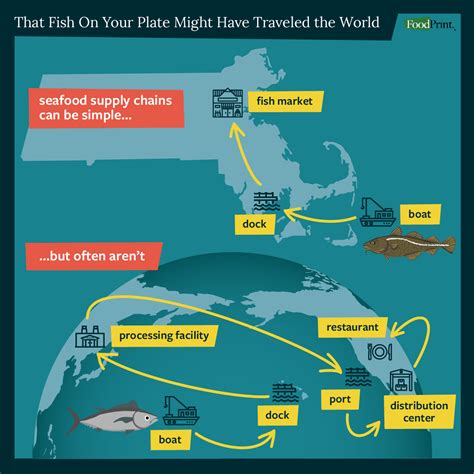
Seafood restaurant chains, after navigating turbulent financial waters exacerbated by the pandemic, inflationary pressures, and shifting consumer preferences, are showing signs of recovery through strategic menu revamps, technological investments, and a renewed focus on value and customer experience.
Several prominent seafood chains, including Red Lobster, once a dominant player in the casual dining segment, faced significant challenges in recent years, prompting closures and restructuring efforts. However, through innovation and adaptation, these chains are aiming to recapture market share and appeal to a new generation of diners. Strategies include streamlined menus featuring more affordable options, enhanced online ordering and delivery systems, and modernized restaurant designs that create a more inviting atmosphere. The industry is cautiously optimistic, citing early indicators of positive sales trends and improved customer satisfaction scores.
The seafood restaurant sector experienced a major downturn following the COVID-19 pandemic. Lockdowns and social distancing measures significantly impacted dine-in traffic, forcing many establishments to rely heavily on takeout and delivery services. Simultaneously, rising food and labor costs put immense pressure on profit margins. Inflation, particularly impacting seafood prices, further compounded the challenges. Consumers, increasingly price-conscious, began seeking more affordable dining options, leading to a decline in customer visits to traditional seafood chains.
Red Lobster, in particular, faced immense financial strain. The chain, known for its Cheddar Bay Biscuits and seafood feasts, struggled to maintain profitability amid changing consumer tastes and increased competition from fast-casual restaurants. Its “Ultimate Endless Shrimp” promotion, while initially popular, reportedly resulted in significant losses, contributing to the company’s decision to file for Chapter 11 bankruptcy protection in May 2024.
However, even amidst these setbacks, signs of resilience and reinvention are emerging across the seafood chain landscape. Companies are embracing new technologies to improve operational efficiency and enhance the customer experience. Online ordering platforms, mobile apps, and loyalty programs are becoming increasingly prevalent, allowing customers to conveniently place orders, track deliveries, and earn rewards. Restaurants are also investing in kitchen automation and data analytics to optimize inventory management and reduce waste.
Menu innovation is also playing a crucial role in the seafood chains’ comeback strategies. Restaurants are introducing new dishes that cater to evolving consumer preferences, such as healthier options, sustainable seafood choices, and globally inspired flavors. Many chains are also focusing on offering more affordable menu items and value-driven promotions to attract budget-conscious diners.
“These chains are looking at ways to cut costs, streamline operations, and become more efficient,” says Neil Saunders, Managing Director of GlobalData Retail. “They also need to think about how they can offer a better experience to customers and make sure they are providing value for money.”
In addition to menu and technology upgrades, many seafood chains are also investing in restaurant renovations and remodels. The goal is to create a more modern and inviting atmosphere that appeals to a broader range of customers. New restaurant designs often feature open kitchens, updated décor, and more comfortable seating arrangements.
The success of these turnaround efforts will depend on several factors, including the ability of seafood chains to adapt to changing consumer preferences, manage costs effectively, and compete with other dining options. The industry also faces ongoing challenges related to seafood sustainability, supply chain disruptions, and labor shortages.
Despite these hurdles, the seafood restaurant sector remains a significant part of the American dining landscape. With a renewed focus on innovation, value, and customer experience, these chains are striving to turn the tide and reclaim their position as popular dining destinations.
Deep Dive into the Strategies and Challenges
The resurgence of seafood chains is not merely a matter of luck but a carefully orchestrated series of strategic decisions designed to address the core issues that led to their initial decline. These strategies can be broadly categorized into operational efficiency, menu innovation, technological adoption, and customer experience enhancement.
Operational Efficiency: One of the primary focuses for struggling chains is streamlining operations to reduce costs and improve profitability. This involves analyzing every aspect of the business, from supply chain management to labor allocation, and identifying areas where efficiencies can be gained.
Supply chain optimization is crucial, particularly in the seafood industry where sourcing fresh, high-quality ingredients can be expensive and complex. Chains are working to establish closer relationships with suppliers, negotiate better pricing, and explore alternative sourcing options to reduce costs. Furthermore, they are implementing advanced inventory management systems to minimize waste and ensure that ingredients are used efficiently.
Labor costs represent a significant portion of operating expenses, and chains are exploring various strategies to optimize labor allocation. This includes using technology to automate tasks, cross-training employees to handle multiple roles, and implementing scheduling systems that match staffing levels to customer demand.
Menu Innovation: The key to attracting and retaining customers lies in offering a compelling menu that caters to diverse tastes and preferences. Seafood chains are responding by introducing new dishes that align with current trends, such as healthier options, sustainable seafood choices, and globally inspired flavors.
Health-conscious consumers are increasingly seeking lighter and more nutritious meal options. Seafood chains are responding by offering grilled or baked seafood dishes, salads with seafood toppings, and vegetable-based sides. They are also providing nutritional information to help customers make informed choices.
Sustainability is another important consideration for many diners. Chains are working to source seafood from sustainable fisheries and aquaculture operations that adhere to responsible environmental practices. They are also promoting sustainable seafood choices on their menus and educating customers about the importance of sustainable fishing.
Globally inspired flavors are gaining popularity, and seafood chains are incorporating these flavors into their menus to appeal to adventurous diners. This includes offering dishes with Asian, Latin American, and Mediterranean influences, such as sushi rolls, ceviche, and seafood paella.
Value is a critical factor for budget-conscious consumers, and chains are responding by offering more affordable menu items and value-driven promotions. This includes offering lunch specials, early bird discounts, and family meal deals. Chains are also experimenting with different pricing strategies to find the optimal balance between profitability and affordability.
Technological Adoption: Technology plays a pivotal role in improving operational efficiency, enhancing the customer experience, and driving sales growth. Seafood chains are investing in various technologies, including online ordering platforms, mobile apps, loyalty programs, kitchen automation systems, and data analytics tools.
Online ordering platforms and mobile apps allow customers to conveniently place orders for takeout or delivery. These platforms also provide opportunities for upselling and cross-selling, as well as collecting customer data for marketing purposes.
Loyalty programs reward customers for their repeat business and encourage them to spend more money. These programs often offer exclusive discounts, free items, and other perks.
Kitchen automation systems can streamline food preparation and reduce labor costs. These systems can automate tasks such as grilling, frying, and assembling dishes.
Data analytics tools provide insights into customer behavior and preferences. These tools can be used to optimize menu offerings, personalize marketing campaigns, and improve operational efficiency.
Customer Experience Enhancement: Providing a positive and memorable customer experience is essential for building loyalty and attracting new customers. Seafood chains are focusing on various aspects of the customer experience, including restaurant ambiance, service quality, and food presentation.
Restaurant renovations and remodels can create a more modern and inviting atmosphere. New restaurant designs often feature open kitchens, updated décor, and more comfortable seating arrangements.
Service quality is a critical factor in customer satisfaction. Chains are investing in training programs to ensure that employees are friendly, knowledgeable, and efficient.
Food presentation is also important. Dishes should be attractively plated and garnished to enhance the dining experience.
The Red Lobster Case Study: A Cautionary Tale and a Potential Turnaround
Red Lobster’s recent bankruptcy filing serves as a cautionary tale for the entire seafood chain industry. The company’s struggles highlight the challenges of adapting to changing consumer preferences, managing costs effectively, and competing in a highly competitive market.
The “Ultimate Endless Shrimp” promotion, while initially popular, reportedly resulted in significant losses. The promotion was designed to attract customers and drive traffic, but it ultimately proved unsustainable due to rising shrimp prices and operational inefficiencies. This misstep underscores the importance of carefully evaluating the financial implications of promotions and ensuring that they are profitable in the long run.
However, even amidst these setbacks, there is potential for a Red Lobster turnaround. The company is undergoing restructuring efforts to streamline operations, reduce debt, and refocus on its core strengths. This includes closing underperforming locations, renegotiating leases, and investing in menu innovation and technology upgrades.
The future of Red Lobster will depend on its ability to successfully execute its turnaround plan and adapt to the evolving needs of the marketplace. The company must find a way to offer compelling value to customers while maintaining profitability. It must also invest in its employees and create a positive work environment to attract and retain talent.
The Competitive Landscape: Beyond Seafood Chains
Seafood chains are not only competing with each other but also with a broader range of dining options, including fast-casual restaurants, casual dining establishments, and grocery stores with prepared food sections.
Fast-casual restaurants, such as Chipotle and Panera Bread, have gained popularity in recent years due to their focus on fresh ingredients, customizable options, and affordable prices. These restaurants offer a convenient and appealing alternative to traditional seafood chains.
Casual dining establishments, such as Applebee’s and TGI Fridays, also compete for customers’ dining dollars. These restaurants offer a wider variety of menu items and a more relaxed atmosphere than seafood chains.
Grocery stores with prepared food sections are becoming increasingly popular as consumers seek convenient and affordable meal options. These stores offer a variety of prepared seafood dishes, such as sushi, shrimp cocktail, and grilled salmon.
To compete effectively, seafood chains must differentiate themselves by offering unique menu items, providing exceptional service, and creating a memorable dining experience. They must also leverage technology to improve efficiency and enhance the customer experience.
The Future of Seafood Chains: Adapting to a Changing World
The seafood chain industry faces ongoing challenges related to seafood sustainability, supply chain disruptions, and labor shortages.
Seafood sustainability is a growing concern for consumers and regulators. Chains must work to source seafood from sustainable fisheries and aquaculture operations that adhere to responsible environmental practices. They must also be transparent about their sourcing practices and educate customers about the importance of sustainable fishing.
Supply chain disruptions can impact the availability and cost of seafood. Chains must diversify their sourcing options and build strong relationships with suppliers to mitigate these risks. They must also invest in technology to track inventory and manage supply chains effectively.
Labor shortages are a persistent challenge for the restaurant industry. Chains must offer competitive wages and benefits to attract and retain talent. They must also invest in training programs to develop skilled employees.
Despite these challenges, the seafood chain industry remains a significant part of the American dining landscape. With a renewed focus on innovation, value, and customer experience, these chains are striving to turn the tide and reclaim their position as popular dining destinations. The ability to adapt to the evolving needs of the consumer, embrace technology, and address the challenges of sustainability and labor will determine the long-term success of these businesses. The chains that can successfully navigate these complexities will be well-positioned to thrive in the years to come.
Frequently Asked Questions (FAQs)
-
Why were seafood chains struggling in recent years?
- Seafood chains faced numerous challenges, including the COVID-19 pandemic’s impact on dine-in traffic, rising food and labor costs, inflationary pressures leading to higher seafood prices, and changing consumer preferences towards more affordable and diverse dining options. Red Lobster’s financial struggles, culminating in bankruptcy, exemplify these difficulties. According to Neil Saunders, Managing Director of GlobalData Retail, “These chains are looking at ways to cut costs, streamline operations, and become more efficient.”
-
What strategies are seafood chains using to make a comeback?
- Seafood chains are employing several strategies to revitalize their businesses. These include menu revamps featuring more affordable options, technological investments to improve online ordering and delivery systems, restaurant renovations to create more inviting atmospheres, a renewed focus on customer service and enhanced loyalty programs. They are also focusing on streamlining operations and cutting costs.
-
What role did the “Ultimate Endless Shrimp” promotion play in Red Lobster’s financial troubles?
- While initially popular, the “Ultimate Endless Shrimp” promotion reportedly led to significant financial losses for Red Lobster. The promotion’s unsustainability, due to rising shrimp prices and operational inefficiencies, contributed to the company’s decision to file for Chapter 11 bankruptcy protection in May 2024. It highlighted the importance of carefully evaluating the financial implications of promotions.
-
How are seafood chains adapting to changing consumer preferences?
- Seafood chains are adapting to evolving consumer tastes by introducing new menu items that cater to healthier options, sustainable seafood choices, and globally inspired flavors. They are also focusing on offering more affordable menu items and value-driven promotions to attract budget-conscious diners. Furthermore, there is an increasing emphasis on transparency regarding sourcing practices to appeal to environmentally conscious customers.
-
What are the main challenges facing seafood chains in the future?
- The future challenges for seafood chains include adapting to ongoing changes in consumer preferences, managing costs effectively, competing with other dining options, ensuring seafood sustainability, mitigating supply chain disruptions, and addressing labor shortages. The ability to navigate these complexities will determine their long-term success.









